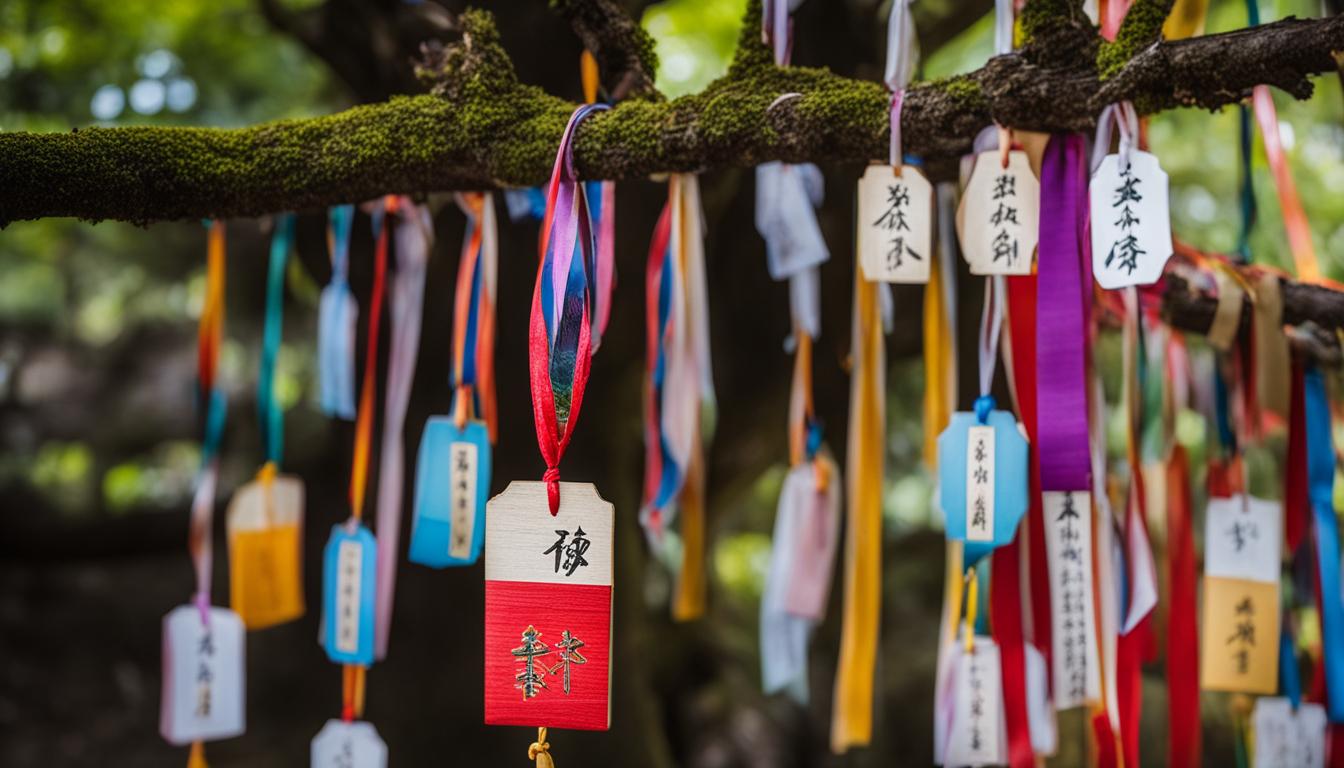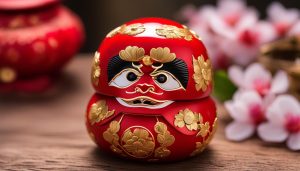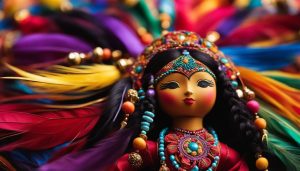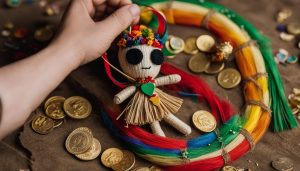In Japan, people have various rituals and customs that they believe will bring them good luck. One such ritual is the practice of sacrificing certain items or making offerings to deities and spirits. These sacrifices can take the form of amulets, talismans, or even human sacrifices in ancient times. Let’s explore the intriguing tales and customs from The Land of the Rising Sun!
Contents
Key Takeaways:
- Japanese rituals and customs are believed to bring good luck.
- Offerings and sacrifices are made to deities and spirits.
- Amulets and talismans play a significant role in Japanese culture.
- The Daruma Doll represents goal achievement in Zen Buddhism.
- The Maneki Neko is a lucky cat figurine associated with wealth and prosperity.
Omamori- Amulets for Luck and Protection
In Japan, the practice of using amulets for luck and protection is deeply rooted in the culture. One such amulet is the Omamori, which can be found at Shinto shrines and Buddhist temples throughout the country. These amulets are believed to provide various forms of good fortune and protection to those who carry them.
The Omamori is typically made from paper or wood and is enclosed in a brocade bag. The bag is intricately designed and often adorned with colorful thread and embroidery. Inside the bag, there is a small piece of paper or cloth inscribed with prayers or blessings, along with other sacred items. Each Omamori is dedicated to a specific Shinto kami or Buddhist figure, representing different aspects of luck and protection.
People usually carry their Omamori with them or hang them in their homes or cars. The belief is that the amulet’s power remains active for one year, and it is customary to return it to the shrine or temple after that period. Many people collect Omamori from different places and display them as a symbol of their spiritual journey and the protection they have received.
Table: Different Types of Omamori and Their Symbolic Meanings
| Omamori Type | Symbolic Meaning |
|---|---|
| Health and Longevity | Protection against illness and a long, healthy life |
| Academic Success | Aid in studying and passing exams |
| Safe Travel | Protection while traveling and a safe return |
| Business Prosperity | Success and good fortune in business ventures |
| Love and Relationships | Attracting love, enhancing relationships, and finding a soulmate |
Whether you believe in the spiritual power of Omamori or not, these amulets serve as a fascinating aspect of Japanese culture and provide a glimpse into the country’s deep-rooted traditions and beliefs.
Daruma Doll – A Symbol of Goal Achievement
When it comes to setting goals and staying motivated, the Japanese have a unique and inspiring tradition in the form of the Daruma Doll. This traditional talisman, rooted in Zen Buddhism, serves as a symbol of commitment, determination, and achievement.
The Daruma Doll is typically made of papier-mâché and features a round, hollow body with a flat base. Its most distinctive feature is the blank eyes, which are intentionally left unfinished. When a person sets a goal or makes a wish, they paint in one eye of the doll, symbolizing the start of their journey. As they make progress towards their goal, they fill in the other eye, signifying its accomplishment.
The symbolism behind the Daruma Doll is deeply rooted in the teachings of Zen Buddhism. The process of setting a goal, painting in the first eye, and working towards its completion reflects the principles of mindfulness, perseverance, and self-discipline. It serves as a physical reminder to stay focused, overcome obstacles, and never lose sight of one’s aspirations.
“The Daruma Doll is not just a mere doll; it represents our aspirations and the unwavering spirit needed to achieve them.”
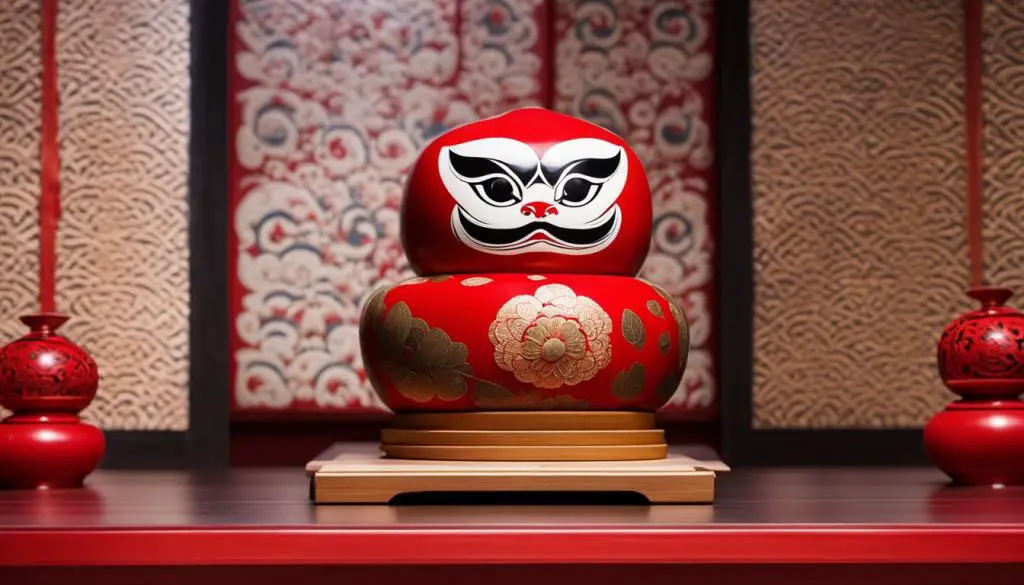
Table: The Journey to Goal Achievement with the Daruma Doll
| Milestone | Description |
|---|---|
| Setting the Goal | Think about what you want to achieve and write down your goal. |
| Painting the First Eye | With a steady hand, carefully paint in one eye of the Daruma Doll. |
| Taking Action | Break down your goal into smaller, manageable tasks and start taking action towards them. |
| Overcoming Challenges | Embrace the inevitable challenges along the way and stay committed to your goal. |
| Completing the Goal | Once your goal is achieved, proudly paint in the second eye of the Daruma Doll. |
The Daruma Doll is not only a cultural icon in Japan but also a powerful symbol of goal achievement and personal growth. It teaches us that success begins with a firm decision and the unwavering determination to overcome obstacles. So, next time you set a goal for yourself, consider embracing the spirit of the Daruma Doll and watch as your dreams become a reality.
Maneki Neko – The Lucky Money Cat
In Japanese culture, the Maneki Neko, also known as the lucky cat, is a widely recognized symbol of wealth and prosperity. This adorable figurine depicts a seated cat with one paw raised in a beckoning gesture. It is believed that the cat’s paw motion invites good fortune and beckons customers and prosperity into homes and businesses.
The Maneki Neko figurine comes in various designs and colors, with each variation signifying a different aspect of luck. The most common colors are white, which represents purity and positivity, and gold, symbolizing wealth and prosperity. Some lucky cats also wear colorful collars and carry different objects, such as coins or a gold ingot, further enhancing their significance.
The raised paw of the Maneki Neko can be either the left or right, with each having a different meaning. A cat with its left paw raised is believed to attract customers and business success, making it a popular choice for shops and restaurants. On the other hand, a cat with its right paw raised is believed to bring good luck and wealth to individuals and households.
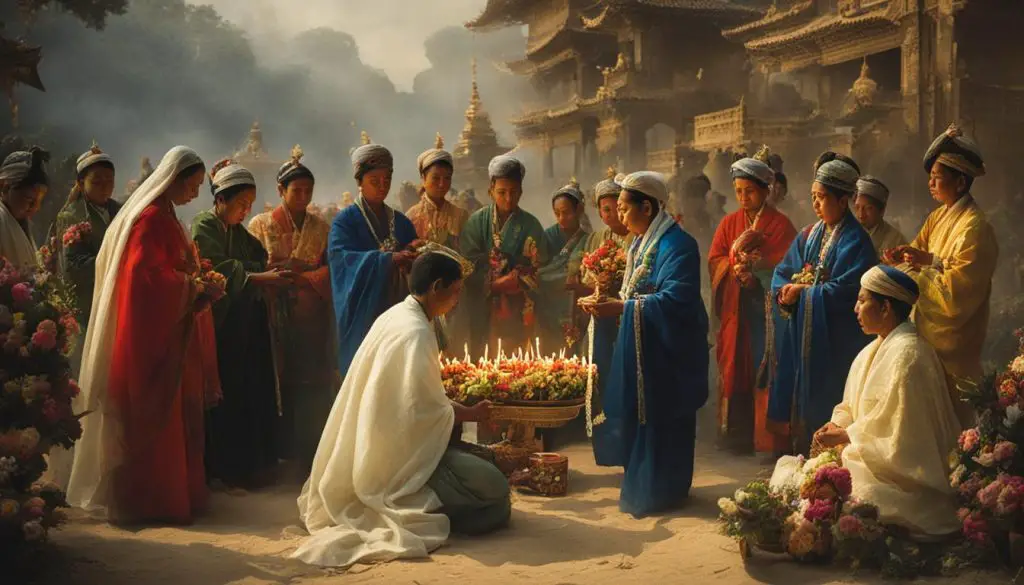
The Significance of the Baci Ceremony
The Baci Ceremony holds great significance in Laotian and Thai culture, reflecting the importance of community, spirituality, and the belief in the interconnectedness of all beings. It is a way to honor and show respect to the spirits, seek their blessings, and restore balance and harmony in one’s life. The ceremony is also believed to strengthen familial bonds, bring good fortune, and provide protection against misfortune and illness.
The Power of Rituals
“The Baci Ceremony is a beautiful example of how rituals can bring people together, infuse meaning into everyday life, and instill a sense of hope, gratitude, and spiritual connection,” says cultural anthropologist Dr. Jane Smith.
Whether one believes in the spiritual aspects of the Baci Ceremony or not, participating in such rituals can be a deeply meaningful and enriching experience. It allows individuals to connect with their cultural heritage, gain a sense of belonging, and reflect on the values of gratitude, respect, and harmony. In a fast-paced and modern world, these rituals serve as a reminder to slow down, appreciate the present moment, and nurture the spiritual aspect of human existence.
Table: Symbolism of White Cotton Strings in the Baci Ceremony
| Number of Knots | Symbolism |
|---|---|
| Three Knots | Health, Wealth, Happiness |
| Five Knots | Balance of the Five Elements |
| Seven Knots | The Seven Chakras |
| Nine Knots | Completeness, Protection, Unity |
Conclusion
Good luck rituals and customs are deeply ingrained in Japanese culture and Asian traditions. These practices serve as a way to invite prosperity, protection, and good fortune into people’s lives. Whether you believe in the power of these rituals or not, they are a fascinating part of Japanese and Asian traditions that have endured throughout history.
The Japanese have a rich spiritual heritage and believe in the power of making offerings at shrines and temples. The use of amulets, such as the Omamori and Daruma Doll, is also common to seek luck and goal achievement. Similarly, the Maneki Neko, or lucky cat, is believed to bring wealth and prosperity to homes and businesses.
These customs are not limited to Japan alone. In Laos and Thailand, the Baci Ceremony is practiced to enhance one’s spirit and attract good luck. Through the tying of white cotton strings and offering prayers, this ritual unites protective spirits within a person, bringing them prosperity, well-being, and good fortune.
Whether it’s the belief in the spirits, the symbolism of the objects, or simply the act of engaging in these rituals, good luck customs are an integral part of Japanese and Asian cultures. They offer a unique insight into the traditions and beliefs that have shaped these societies for centuries.
FAQ
What are Omamori?
Omamori are Japanese amulets sold at Shinto shrines and Buddhist temples. They are believed to bring luck and protection to the person who carries them.
What is the significance of the Daruma Doll?
The Daruma Doll is a talisman that represents the founder of Zen Buddhism. It is used as a reminder of one’s commitment and determination to achieve goals.
What is the Maneki Neko?
The Maneki Neko, also known as the lucky cat, is a figurine believed to bring wealth and prosperity. It is often placed in homes or businesses to attract good fortune.
What is the Baci Ceremony?
The Baci Ceremony is a traditional ritual practiced in Laos and Thailand. It involves tying white cotton strings around a person’s wrists to enhance their spirit and bring good luck.

